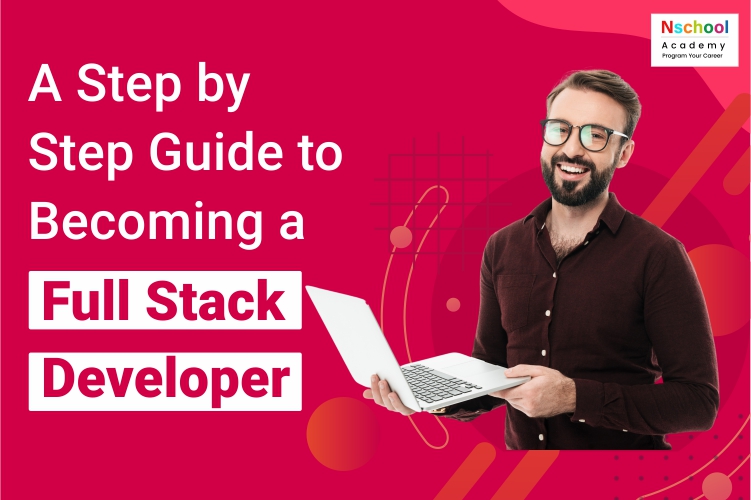- January 9, 2023
- nschool
- 0

How to Build a Website From Scratch: A Step-by-Step Guide to Becoming a Full Stack Developer
To become a Full-stack developer, you must instead become qualified in two essential fundamental web development concepts: the front end and the back end. The front end, also known as the client-side or customer-facing side, refers to all aspects of a computer program with which consumers interact directly. On the other hand, the back end includes all the technology that works behind the scenes to calculate business logic, perform user requests, and permanently store sensitive data.
Front-end developers design and optimize visible elements of a website, making them responsive to diverse viewing situations such as smartphones, tablets, and desktop computers. They employ client-facing programming languages such as HTML, CSS, and JavaScript to create an appealing site. On the other hand, back-end development necessitates programmers creating and refining the internal software that runs a company’s databases, servers, and proprietary software. Back-end developers are in charge of designing the paths that transfer information to and from front-end interface users.
What exactly is the front end in Full Stack web development?
This skill set concerns the actual appearance of your Website and how the information on your Website is shown in browsers and mobile devices. Everything you see on a website, the layout, text and picture positions, colors, fonts, and buttons, are all aspects the front-end developer must consider. A committed front-end developer will be well-versed in HTML, CSS, and JavaScript. The Developer can use these languages to change a website’s content to make it more attractive and practical.
If you want to start studying these languages, Our Nschool Academy, Full Stack course is the Perfect Solution. We suggest getting started coding and constructing things as soon as possible; these languages will help you get there. A front-end developer’s primary purpose is to offer a platform for visitors to engage with, a platform that gives and receives information. It implies that some developers will be familiar with web design and use applications like Photoshop and Illustrator to generate images and themed layouts.
What is Full Stack back-end web development?
Back-end development is commonly connected with data creation, editing/updating, and data gathering. PHP, Ruby, and, perhaps most notably, Python are popular scripting languages. A back-end developer can use these languages to design algorithms and business logic to alter data obtained from front-end development. It means that a back-end developer must be able to build code to collect user input and save it elsewhere, such as a database.
Databases are categorized into relational (such as PostgreSQL and MySQL) and non-relational managing systems (like Mongo). SQL is the database management language that allows the Developer to communicate with the database. You may get started with it by reading our SQL primer. The principles may appear strange, but remember that several database management systems depend on convenience and ease of use.
What is a Full-stack web developer?
Full-stack developers are proficient in a website’s front-end and back-end technologies. They are well-versed in front-end and back-end languages, frameworks, servers, networks, and hosting infrastructures. Most Full-stack engineers will have spent several years working in various positions to get this breadth and depth of expertise. They also tend to be well-versed in business logic and user experience, which means they can get hands-on, lead, and counsel on strategy.
How to build a website step by step in Full Stack Development?
Let us have a look at the various stages required to learn how to construct a website from scratch in Full Stack Development:
- Create content with HTML
- Style and design with CSS
- Add interactivity with JavaScript
- Using PHP with a database system
- Setting up the MySQL database
Create content with HTML
Most websites you visit regularly are web apps rather than “simply” websites. They enable you to build a user profile and save your data for future use. Of fact, web apps are frequently large-scale undertakings involving entire teams of engineers and designers. This essay will focus on something more simple but still precious. Create a website with three primary sections:
- Content and structure
- Styling and design
- Dynamic and interactivity
What is HTML?
HTML stands for Hyper Text Markup Language and is used to create web pages and online applications. Let us define Hypertext Markup Language (HTML) and a Web page. HyperText is an abbreviation for “Text inside Text.” A hypertext is a text that contains a link. You have used hypertext when you click on a link that takes you to a new webpage. HyperText is a procedure of combining two or more web pages (HTML documents). Language of markup: A markup language is a computer language applying layout and formatting principles to text documents. Markup language improves the interactive and dynamic core of the text. It can transform the text into tables, graphics, links , Etc.
- Headings and paragraphs
- Lists and tables
- Images and other media Etc.
HTML establish a clear framework and the content on your web page. For example, you will use HTML to divide the navigation bar from the rest of your web page’s content. You may also split the content area into portions like I have done above, with the main text area and the sidebar on the right (or at the bottom if you use a mobile device).
Style and design with CSS
After you have mastered the principles of HTML, it is time to study CSS or Cascading Style Sheets. CSS is all about styling your HTML text to make it more attractive and straightforward to read. CSS, like HTML, is a simple language to learn. Before studying CSS, you do not need coding or web development knowledge. Furthermore, because it works in tandem with HTML, it is a good idea to master them simultaneously.
What is Exactly CSS?
When creating a website from the ground up, HTML can only go so far. Yes, you use HTML to produce the actual content for your Website, but you need to do more to make it appear excellent. What may CSS be used to style? So, what precisely can CSS be used to style and design? Almost anything. Whatever HTML content you have created, you can select and change the appearance of any element or section on your page, such as:
- Colors
- Fonts
- Decorations
- Positioning
- Spacing, padding, border, Etc.
Add Interactivity with JavaScript:
So far, your web page includes HTML content and has been embellished with CSS. Excellent work! Making your Website more interactive is the next stage. After all, your HTML/CSS web page is relatively static and does not provide much interaction with its visitors. As a result, you want your visitors to be able to navigate your site effortlessly while adding some dynamic touches. It will make your Website more visually appealing and improve user experience. You will need to learn JavaScript, a programming language. JavaScript is now one of the most popular and commonly used online languages.
What is JavaScript?
JavaScript (js) is a lightweight, object-oriented programming language that scripts webpages on many websites. When applied to an HTML document, it is an interpreted, full-fledged programming language that enables dynamic interactivity on websites. JavaScript was first used in 1995 to add web applications to the Netscape Navigator browser. All other graphical web browsers have since adopted it. Users may use JavaScript to create contemporary web applications that allow them to engage without having to reload the page every time. The typical Website uses js to give various levels of interactivity and simplicity.
AngularJS is a Great Solution
Angular is the quickest path to a Minimum Viable Product and the most Future-Proof means for us to construct a genuine modern “single page.” Web app that will cover all foreseeable demands, from the most basic Website to the most complex Web Application. We envision an index.html file that serves as a template for our whole Website, allowing us to avoid repeating ourselves in all those other HTML files. In our ideal world, we could edit a site-wide element (such as the navigation menu at the top of the page) with a single line of code to change its design across all of the Website’s pages simultaneously!
Why React Native for Web Development?
Because it is a new idea and technology, React Native Web does not yet have as extensive a community as react. The good news is that you’ll discover a lot of help online. You may look for help on StackOverflow or submit bugs to the official Github repository, which can be found at https://github.com/necolas/react-native-web. You may also use reputable organizations to help you comprehend and properly implement react-native-web.
Conclusion:
Full stack development permits you to perform on advanced technology, experimenting with outstanding solutions with progressive enterprises. Furthermore, because the sector continually expands, it provides significant career potential and security to tech-savvy coders looking to create a name for themselves in the programming area.
Why haven’t you started working toward becoming a web developer?
Consider your educational options today; there is no more suitable time than the present to begin developing your ambitions and securing meaningful employment. Check Nschool Academy’s dedicated Full Stack training courses with Real-Time projects in Coimbatore for a fabulous location to start your new experience.

